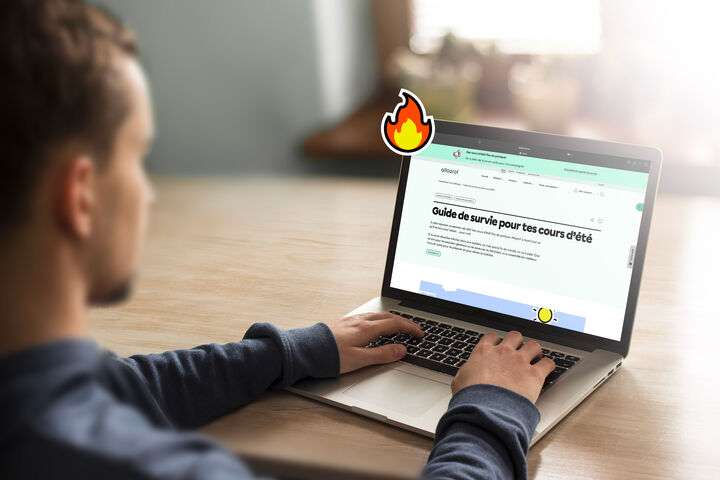Parce qu’ils créent un contexte signifiant pour les élèves, les blogues développent le goût et la fierté d’écrire en améliorant la qualité des écrits. Nancy Dubois, enseignante à la commission scolaire des Affluents, expérimente depuis trois ans le blogue pédagogique en classe. Elle a partagé ses expérimentations lors d’un atelier offert dans le cadre du colloque de l’AQUOPS.
Le plaisir d’écrire
« Pour bloguer avec ses élèves, il faut aimer écrire, confie l’enseignante au troisième cycle. Je me suis moi-même laissé prendre. Je me gâte chaque fois que je rédige le billet annonçant le prochain sujet! » Le blogue étant un outil flexible, elle adapte ses projets selon la personnalité de sa classe et l’inspiration du moment. Ainsi, les jeunes blogueurs explorent différents styles littéraires tels que le conte, la bande dessinée, le calligramme, la critique, la légende ou la lettre d’opinion.
« C’est plus l’fun que d’écrire en classe », confie un de ses élèves. Il semble qu’il ne soit pas le seul à le penser, puisqu’à la demande du ministère de l’Éducation, une équipe de chercheurs de l’Université du Québec à Chicoutimi s’est penchée sur les vertus pédagogiques du blogue. Parmi les points saillants de leur revue de littérature, on constate que l’utilisation du blogue a été appréciée et jugée motivante par plusieurs groupes d’élèves.
Le portrait d’une année scolaire
En septembre, le premier billet signé par ses élèves a été une invitation à la rencontre de parents du début d’année scolaire. Cela permet aux parents de briser la glace et de démystifier cette nouvelle approche pédagogique qui les effraiera moins lorsqu’elle sera intégrée aux devoirs et leçons. Un signet leur est également remis pour les inviter à consulter le blogue régulièrement.
En octobre ou novembre, ses élèves font un autre pas dans la blogosphère. Au cours des dernières années, elle les a invités à explorer le monde des légendes ou encore celui de l’action communautaire. « J’aime varier mes approches et présenter les thèmes en vedette de manière personnelle et originale, explique-t-elle. Ça donne à l’écriture tout son sens ».
Puis, en décembre, l’enseignante se laisse inspirer selon les évènements reliés à l’actualité ou au calendrier. Évidemment, le conte de Noël est un incontournable. « En intégrant le blogue à une activité que j’avais déjà l’habitude de faire, ça allège le tout », précise-t-elle. Pour varier l’approche, ses élèves produisent des fichiers sonores pour narrer leur histoire ou les ponctuent à l’aide d’illustrations. Cette année, ses élèves ont aussi abordé le texte d’opinion en bloguant sur le délicat thème de l’intimidation. « Le fait d’écrire sous un pseudonyme leur a permis de s’exprimer en toute quiétude, confie-t-elle. Cela a permis à un élève qui avait tendance à adopter des comportements inappropriés de se prendre en main. Par écrit, il s’est engagé à ne plus intimider les autres. »
Après les Fêtes, les élèves touchent à la critique littéraire en se prononçant sur les romans jeunesse de Patrick Sénécal. « Quand ils savent qu’ils seront lus, les élèves s’engagent dans le processus et mettent plus d’accent sur la correction de leurs erreurs, exprime l’enseignante. C’est avec impatience que mes élèves attendent la réponse de l’auteur! »
Jumeler poésie, arts plastiques et blogue est un autre projet qui a été mis en branle par Nancy Dubois. « C’est sous la forme de calligrammes que nous avons eu envie de publier les poèmes écrits, plaçant ainsi les réalisations plastiques sur le blogue. » Enfin, pour clore l’année en beauté, les élèves rédigent une lettre où ils se projettent dans le futur. Cette démarche leur permet de décrire leur parcours scolaire et de faire appel à leurs rêves et à leurs passions.
Qu’en pensent les parents?
Après ces trois années d’expérimentation, le projet est positif. « Ça apporte de la fierté aux enfants » et « Ça les responsabilise et les initie à divers sujets d’actualité » ont indiqué les parents dans le sondage envoyé par l’enseignante. Certains disent même qu’il serait agréable de faire des billets avec leur enfant plus souvent.





